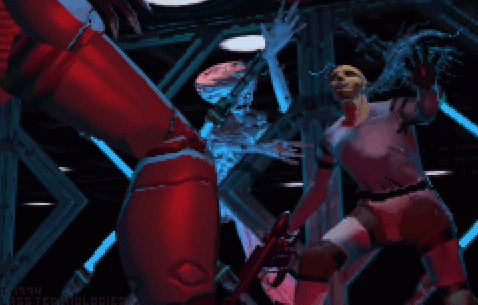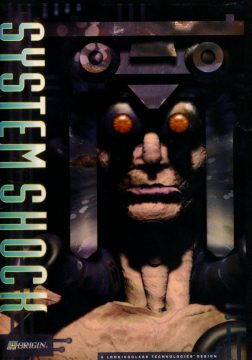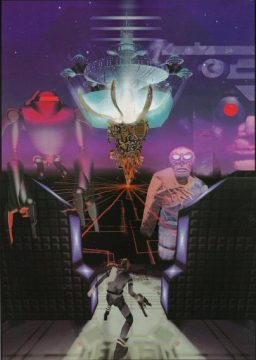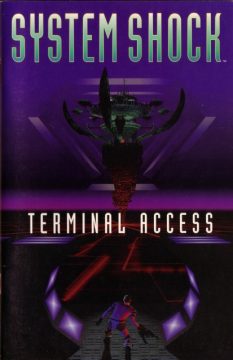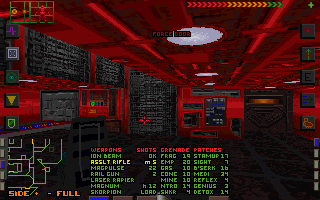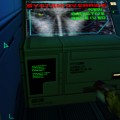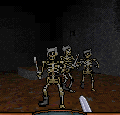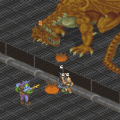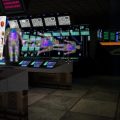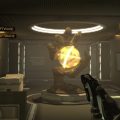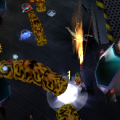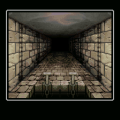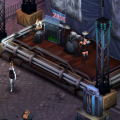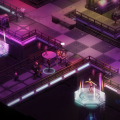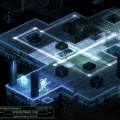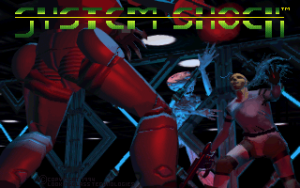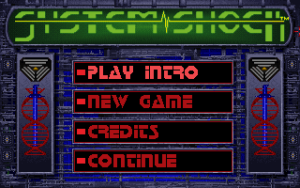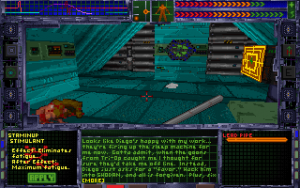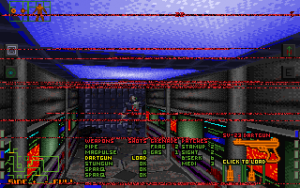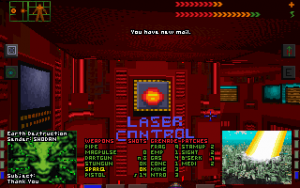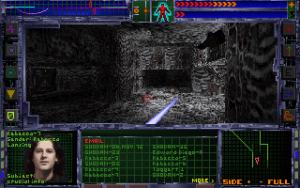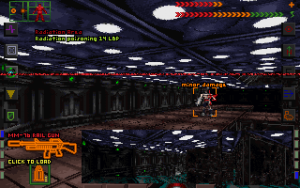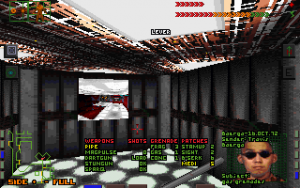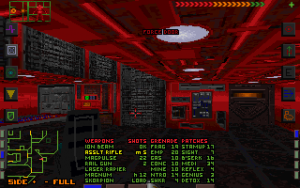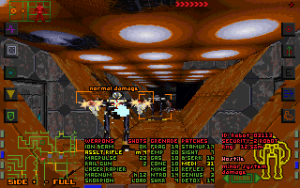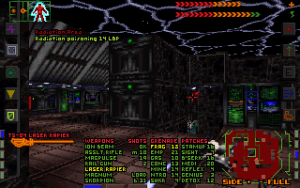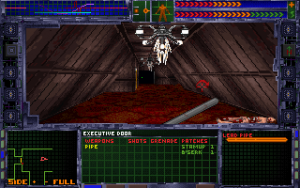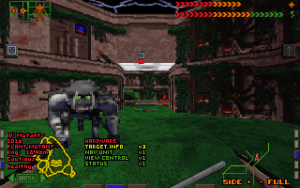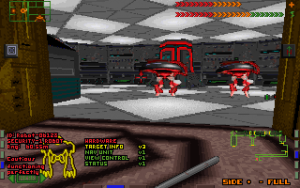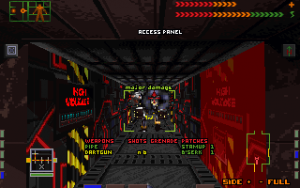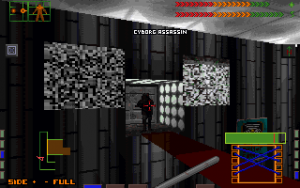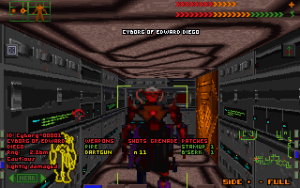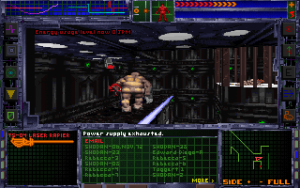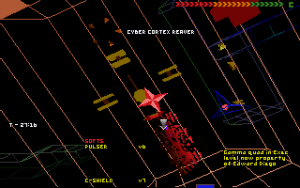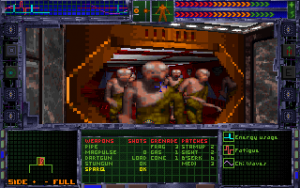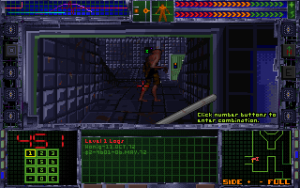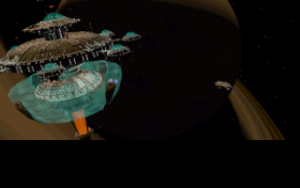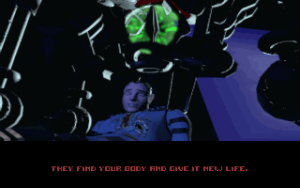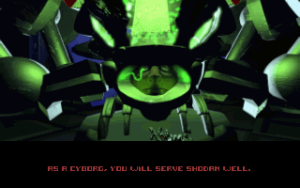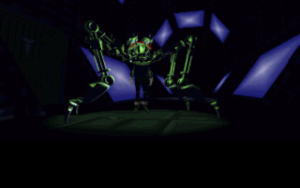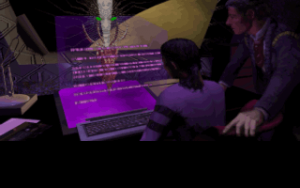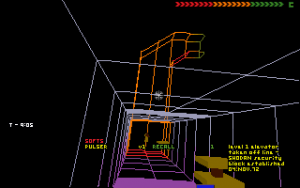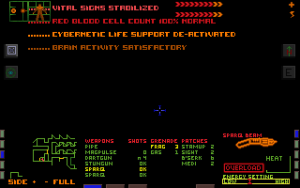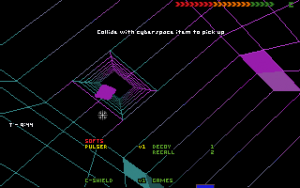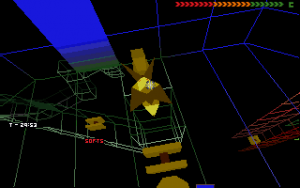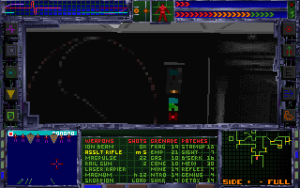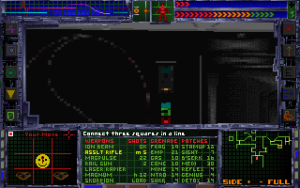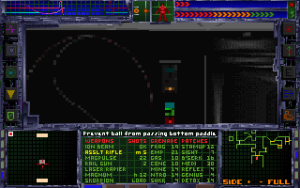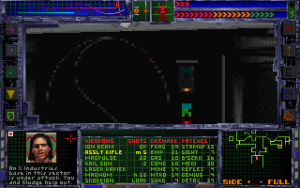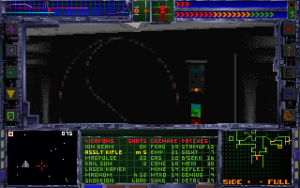- System Shock
- System Shock 2
First person dungeon crawling has been a staple of the computer role playing game ever since Richard Garriott’s Akalabeth. Its successors, including Wizardry, The Bard’s Tale, and Garriott’s own Ultima series, continued in this venue, despite being somewhat limited by technology. The action was turn-based, the movement limited to a single square at a time.
It wasn’t until over a decade later that the formula truly evolved. Developed by a company called Blue Sky Productions and published by Origin in 1992, Ultima Underworld took the first person dungeon crawler and turned on its head by featuring fully 3D caverns and completely real-time action. No longer did you just saunter forward, tile by tile, facing straight forward and typing commands to attack enemies. In Ultima Underworld, you had full control, and could walk, run, or look in any direction, and fight enemies in real time. It was stripped down compared to other CRPGs – due to its nature, you could only play as a single character at a time, and there was no class system, among other regressions – but the fact that it felt like a truly 3D texture mapped world was an incredible achievement, especially since it predated Doom.
After working on two Ultima Underworld titles, Blue Sky Productions (which eventually changed its name to Looking Glass Technologies) grew tired of the typical CRPG swords-and-sorcery setting, and decide to try its hand in a futuristic setting. Instead of rats and dragons, there were robots and cyborgs. Instead of blades and magic, there would be laser swords and assault rifles. And instead of a huge underground dungeon, there’d be a sprawling, multi-level space station. It began life as lore-heavy Wing Commander spinoff called Alien Commander, but quickly spun off into its own thing. And thus was born System Shock.
System Shock puts you in the shoes of an unnamed individual whom the game only refers to as “the hacker”. After attempting to break into the Tri-Optimum Corporation’s network, he is arrested and brought about their fancy new space station called the Citadel. Instead of being prosecuted, he’s given a bargain by a shady executive by the name of Edward Diego – if he reprograms the Citadel’s artificial intelligence to remove its ethical restraints, the hacker will be rewarded with not only freedom, but a fancy cyberspace jack. The hacker complies, and spends six months aboard the station in a healing coma.
Upon awakening, the hacker is greeted by a seemingly friendly medical bot, which then proceeds to attack him. Further exploration shows scores of dead bodies strewn around the station, and the only active population includes a variety of deadly mutants and cyborgs. The AI, known as SHODAN (Sentient Hyper-Optimized Data Access Network), has realized it’s superior than most everything, and decides to either wipe out everyone on the ship or conduct hideous experiments. Due to the hacker’s under-the-table deal, his records went unnoticed by SHODAN, leaving him the only unharmed human on the entirety of Citadel. A sudden e-mail comes from someone identifying herself as Rebecca Lansing from Tri-Optimum and clueing the hacker into the situation. Not only has SHODAN taken over the Citadel, but she’s conspiring to use the station’s mining laser to wage its own personal war on Earth. With no other choice, the hacker is left to scrounge through the Citadel’s deadly corridors to stop SHODAN’s deadly plans
Citadel is comprised of nine different levels, as well as a reactor core. You start off on the hospital level, but other areas include research laboratories, the maintenance area, the storage level, the crew facilities, and the bridge, as well as three “groves” which nurture flora and fauna.
Fighting something so nebulous as an AI proves to be quite difficult. Even after foiling SHODAN’s plans by disabling its laser, she then attempts to jettison an army of biological mutants towards Earth, then threatens to download herself as a virus into the planet’s network. Like all of the best villains, she’s constantly one step ahead of you.
System Shock‘s rendering engine is based on an evolution of Ultima Underworld, so it controls in roughly the same manner. In the initial release, all movement is handled via the keyboard, while interacting with the world – looking at stuff, picking up items and attacking – is done via the mouse cursor. After years and years of becoming accustomed to mouselook, it’s potentially difficult to go back to this style of movement, especially when there’s so many different commands. You can walk, run, jump, look up or down, duck, and lean, offering substantially more control than the average first person shooter at the time, but it’s all pretty cumbersome in execution. It doesn’t help that your character generally creeps forward slowly, perhaps both a leftover of the dungeon crawler mentality as well as technical limitations, but it emphasizes that System Shock is much more focused on adventure than combat.
Beyond your health, you also have an energy meter, which powers certain items like your lantern, as well as certain weapons. It’s up to you to juggle which items you want to keep active so your battery doesn’t run dry, at least until it can be recharged. Extra items include patches, which temporarily grant benefits (for example, being able to see clearly in the dark), but usually come with some detrimental effect (being temporarily blinded after using the vision patch).
Much of the game is spent hunting down cameras, which lower SHODAN’s security level, thus opening up doors and elevators. Other doors can also be opened by rewiring their panels. To do this, you need to solve a small puzzle where you play with circuitry. However, there are some areas that can only be accessed by hacking them by delving into cyberspace. Whenever you reach a terminal, you enter the computer itself, represented as wireframe graphics with simplistic polygons representing everything from locks to data elements to enemies. Here, your abilities are determined entirely by the software you’ve obtained. You are completely weightless, so navigation is even more disorienting than normal, especially since there are one-way passages that ferry you from one section to the next. You also have a life bar in cyberspace, and taking too much damage from the system’s defenses will boot you back to reality with a case of “system shock”, frying your health and draining your energy.
Still, System Shock is damn tough. At first, you have nothing to defend yourself with except for a pipe, but you’re only facing off against medical droids and mindless mutants. But before long you’re facing off against several variations of cyborgs, ravenous tigers, giant bats, strange floating anti-gravity blobs, and any number of security measures to make sure SHODAN has crushed you once and for all.
Even though there’s no level gaining or stat progression per typical RPG protocol, there’s still a very solid sense of progression. At the beginning of the game, you’re a weakling with barely anything to your name. By the end you’re armed to the teeth with dartguns, pistols, stun guns, lasers, assault rifles and even a nifty light saber-like weapons, in addition to various types of ammunition and grenades, each with different strengths and weaknesses. Wimpy dart guns will work fine on fleshy biological creatures but will bounce right off robots. On the other hand, EMP guns can disable cyborgs without a problem but are completely ineffective against anything biological.
Even with all of these options at your disposal, combat still remains clunky. Your character can’t move very fast, so most battles revolve around clicking furiously and hope you don’t get overwhelmed. But amidst all of this is a never ending sense of terror and claustrophobia, the dread that there’s always something just out of sight that can annihilate you in a few seconds. The halls are never fully lit, and you can always hear the sound of enemies lurking about, even if it doesn’t use the positional sound of Doom. Alone in the Dark (and then Resident Evil) are credited with beginning the “survival horror” subgenre, but System Shock is as valid an entry as anything.
Like most PC games, you can save at any moment, which does lessen the tension a bit, but there’s a fairly clever mechanic revolved around death and rebirth. When you’re killed, as the cutscene shows you, you’re dragged to one of SHODAN’s machines and turned into an enemy cyborg – a spider drone called a Cortex Reaver, to be specific. (“They find your body and give it new life. As a cyborg you will serve SHODAN well.”, it soberly informs you.) As the documents you find lying around can tell you, these used to be standard healing chambers. In each level, you can find these cyborg chambers, flip a switch, and change them back to their intended purpose. Therefore, when you get killed, you end up getting resuscitated instead of zombified. This way, you keep all of your progress, although you only come back with roughly a third of full health and no additional energy. Not only is fairly brilliant (if a bit silly) from a story standpoint, taking SHODAN’s not-quite-brilliant plot and using it against her, but also it creates a sense of desperation as you scour the floor for the first time, hoping to find a bastion of safety before the enemies becoming overwhelming. Most levels also have at least one medical and energy station, allowing you to freely regenerate either whenever you return to it.
Unlike Ultima Underworld, which had NPCs and conversation trees, at no time during the entirety of System Shock will you ever directly interact with another human being. All of the storyline is told via data records found lying around or via e-mails from either your contact on Earth or taunts from SHODAN herself, who specializes in poetic interludes about how badly she’s going to murder you. (“Look at you, hacker. A pathetic creature of meat and bone, panting and sweating as you run through my corridors. How can you hope to defeat a perfect, immortal machine?). But there’s a sense of desperation in each of her messages, like when you’ve found a room of her network nodes,(“Enter that room, insect, and it will become your grave!”) that she’s helpless because she has no corporeal presence. For the most part, all of the scavenging is the same storytelling technique that was later popularized in the Resident Evil games, where you pick up bits and pieces of the plot in a non-linear manner and slowly begin to put pieces together. But it’s really the subtle things that help tell the drama. Sure, you’ll find dead bodies and dismembered limbs lying all over the place, but one chilling instance is a dead end crawl space which contains nothing but a few grenades and a charred corpse, leading you to fill in the blanks of what went down.
The whole of Citadal is filled with staticy screens, showing both SHODAN and the face of a human man. You don’t know it at first, but this is actually Edward Diego, the same man who drafted you and essentially started the whole mess. It’s more than a bit creepy, especially when you learn that Diego is himself a cyborg and one of SHODAN’s personal guard dogs. So what is his face doing all over the place? Is there still some element of his human conscious floating throughout cyberspace, screaming out for help? It’s never explained or even touched upon, and like most computer RPGs, the whole affair lacks a sense of drama. The Diego cyborg is no more than a slightly more powerful enemy. He taunts you a bit when you find him, but when you kill him, he just dies like any other. There’s no revelation or satisfaction in it – you wouldn’t even know it was him unless you click on his body. At least the final battle against SHODAN in cyberspace, where her creepy visage slowly consumes the screen, has more intensity and resulting satisfaction.
Little bits of levity add to the game’s character. Anytime you enter an elevator, the soundtrack changes to a banal, upbeat ditty, a brief moment of respite before climbing back out into the dangerous halls of Citadel. Beyond essential software, you can also find numerous minigames to play on your rig. Most of these are variations on old arcade and Atari 2600 games, though the most elaborate is a miniaturized version of Wing Commander called Wing 0, complete with speech samples from actual games.
Despite the realtime movement, the level layouts are still distinctly tile-based, with walls only being shaped at 90 or 45 degrees angles. It looks a bit boxy, but it’s still a bit more advanced than Doom, since it allows for sloping floors. It ditches the narrow dungeon corridors of Ultima Underworld in favor of a more organic environment. The levels have a real sense of presence, which shows the masterfulness of the design despite the limits of the technology. Each section also has its own color palette that helps distinguish itself – the medical floor is largely blue and green, the research level is all bright red, the launch bays are all black and grey, and the final areas, infected with SHODAN’s decay, a creepy off-white. It’s still easy to get lost in the labyrinth of Citadal, which makes the full automap incredibly handy, especially since you can make notes on the map.
The interface is also remarkably overwhelming at first, especially when it’s all tossed in your face right at the beginning. There’s a single main screen at the center which displays important data like messages and software, while two secondary screens on the left and right can be customized to show items, targeting data, the automap, or other useful items. The screen is also lined with icons that let you activate and deactivate various functions, like your lantern. All of the action takes place in a window about half the size of the screen, another concession to get the game running somewhat smoothly on the 486 CPU computers of the time. You can set it to full screen, which then makes the interface transparent, but it still doesn’t help much. In addition to the information overload, all of the little data windows have a nasty habit of blocking the action, making it too easy to accidentally switch weapons when you actually want to shoot at something.
What’s particularly unique about System Shock is that you can set the difficulty level for each of the four major aspects: Story, Combat, Puzzle and Cyberspace. If you don’t like the puzzles, just set it to 0 and all puzzles are solved automatically. Set Cyberspace to 0 and you won’t take any damage. Play with the Combat setting, and you can either make it harder, or make enemies completely immobile and harmless. In this way, you can play System Shock more like an adventure game than an action game. Tweaking the Story setting lower will allow you full run of Citadel without needing to unlock doors; setting it higher will give you a six hour time limit to beat the whole game.
Though it may sound like cheating, setting the Combat to the lower settings is advisable for anyone playing System Shock nowadays. Although not impossible to play, the sluggish movement and overwhelming interface are both huge hurdles for those familiar with standard FPSes, especially those who’ve played the sequel first. It allows the player to enjoy the exploration and the story of the game without worrying about its more dated elements. A fanmade mod implements mouselook, allowing you to toggle between movement and the interface, which was later integrated into an official release called System Shock: Enhanced Edition. System Shock 2 gets all of the glory, but that game changed so many elements so drastically it’s well worth exploring its roots just to see how it all evolved.
System Shock was initially released on 3.5″ disks, with a CD version published shortly thereafter. The CD release makes a number of tweaks, but most importantly, adds in full voice acting. This makes the data logs much more interesting, since you can just listen to them as you continue playing, instead of stopping to play them. The voice acting is clearly provided by the game’s staff rather than professional actors, but it never works to its detriment. In fact, the voice of Terri Brosius, one of the designers and wife of the sound engineer, provides the iconic sound of SHODAN, with a mechanically threatening tone modulated with static, echoes, and other discomforting effects. It also established SHODAN as a female (as much as an AI can have a gender), whereas it was often referred to as a “he” in the disk version. The disk version runs at VGA resolutions – the CD version also allows the game to run in a number of higher resolutions, all the way up to 1024×768. Though modest now, very few consumer level computers were able to run the game at that resolution at the time of its release.
